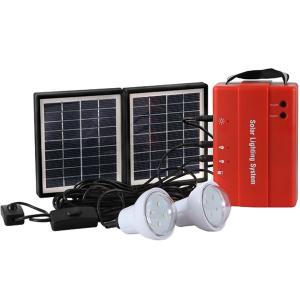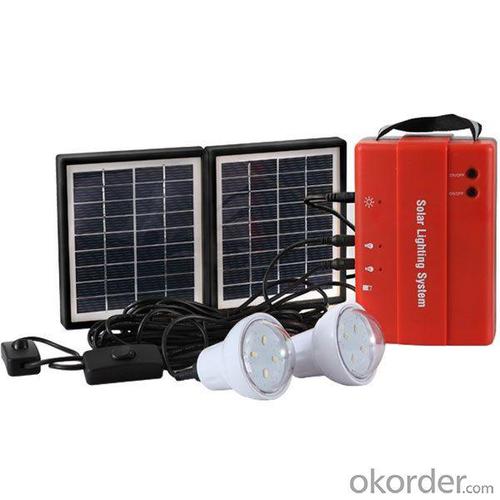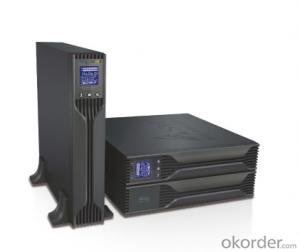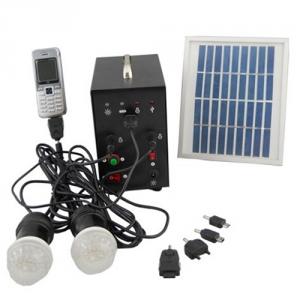Sun Tec Solar Energy Systems 3.4w Solar Lighting System with Mobile Charge LED Bulb Light Outdoor 3.4w Solar Panel 4500mAh Battery CE
- Loading Port:
- Shenzhen
- Payment Terms:
- TT/LC
- Min Order Qty:
- 100Sets set
- Supply Capability:
- 20000 SETS Per Month set/month
OKorder Service Pledge
OKorder Financial Service
You Might Also Like
This 3.4w 9v solar panel solar lighting system with mobile charge 4500mAH 6v and 2 led globe bulbs. This portable solar energy system can generate power for 2 LED bulbs, it can work 15 to 30 hours every day.
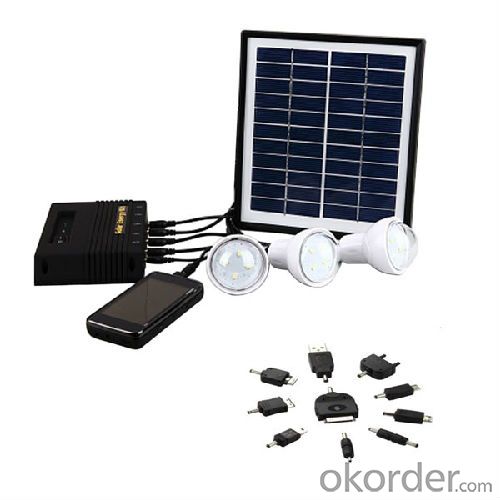
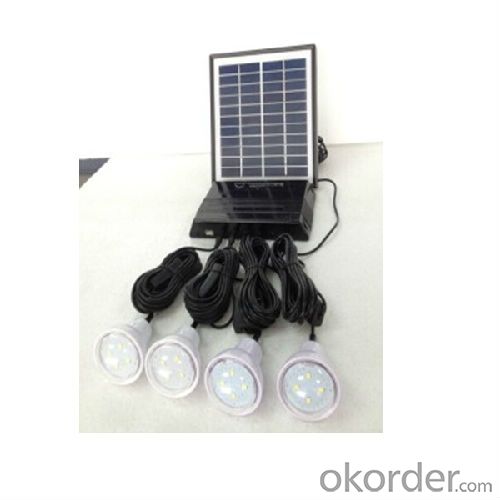

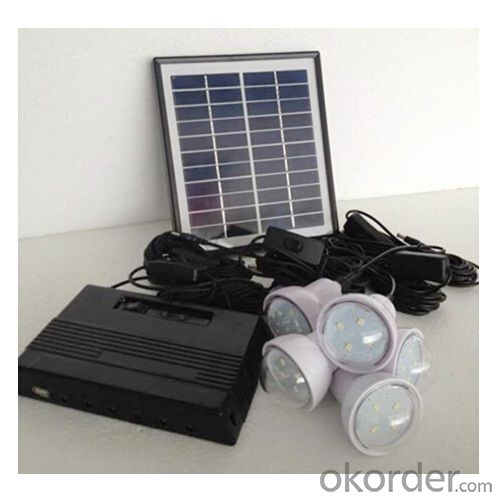
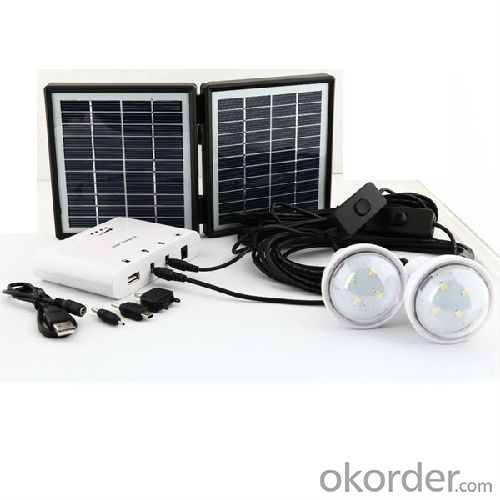
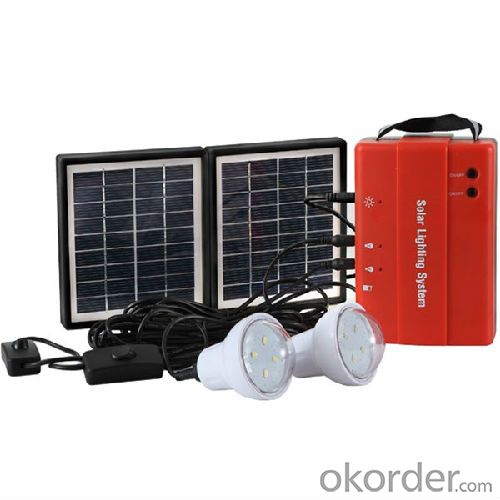
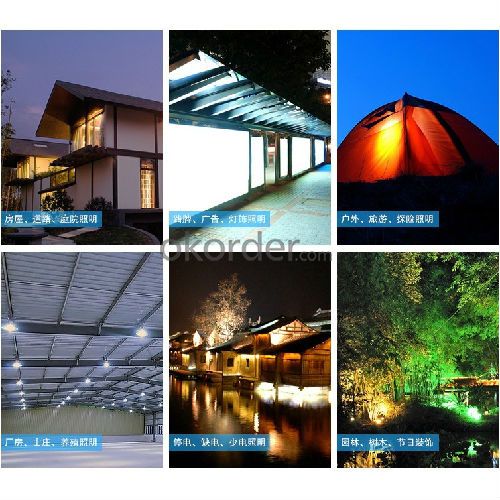
Parameter
1, Rechargeable by solar or AC adaptor;
2 With 10 in 1 USB mobile phone charger
3. Housing material: ABS;
4. Battery: 4.5AH/6V maintenance free Lead-acid ;
5. Lighting time: 30 hours after fully charged; 10hrs after one day charge by sun.
6. Accessory: two bulbs with 5M long cable(with switch on the cable)
7.Over charge and over discharge protection.
| Application: Home |
| Output Voltage (V): 9V |
| Load Power (W): Depends |
| Solar Power (W): 3.4W |
| Work Time (h): 15-30hours |
| Solar Panel: 9V 1.7W *2pcs |
| Battery type: 6V 4.5AH Lead-acid battery |
| Material: ABS |
| Usage: indoor home lighting & outdoor lighting |
| Light source: 0.9W 90lumens |
| Color: red |
| Optional charging: 8V AC adaptor |
| IP level of solar panel and bulb: IP65 |
| IP level of control box: IP44 |
| USB output: 5V 500MA |
Feature
1, Foldable solar panels
2, With 10 in 1 USB phone charger and 2pcs of LED bulbs
3, CE
Usage/Applications
Rural homes, campers, fishermen, outdoor campaigns or activities, etc. Remote area, mountainous area, desert area, grassland area,
Village, country area, Camping, outdoor activities, travel, Lighting at night.
Customized options
1. OEM/ODM available;
2. It's also available to customize your own solar lighting systems, solar lanterns, or any solar lighitng products by giving us solar lights picture / 3D draft / technical datas.
Packing & Delivery
Package:
1* solar panel
1* portable system box
2* LED bulbs with on/off button on cable
inner box size: 190*140*170mm
12pcs/carton
carton size: 580*305*355mm
Delivery:
|
Shipping Service |
Estimated Delivery Time |
|
DHL |
2-8 business days |
|
FedEx |
3-8 business days |
|
TNT |
2-10 business days |
|
UPS |
1-7 business days |
|
EMS |
6-14 business days |
|
ePacket |
7-12 business days |
|
China Post Air Mail |
7-15 business days |
|
China Post SAL |
14-30 business days |
|
Air freight |
3-10 business days |
|
By Sea |
30-40 business days |
1. 3-5 business days for Sample Orders; 7-30 business days for Bulk Orders for Bulk Orders.
2. "Business days" means Monday-Friday, excluding holidays.
3. DHL and UPS cannot ship to military or P.O. boxes address
4. The Shipping Service above is for reference only, for any other questions, please feel free to contact us.
Factory
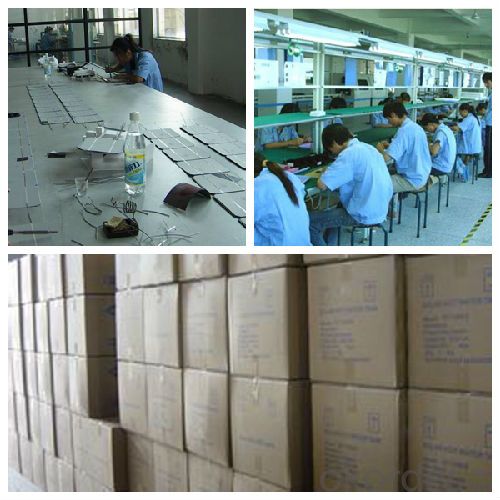
- Q: How do solar energy systems impact greenhouse gas emissions?
- Solar energy systems have a significant positive impact on reducing greenhouse gas emissions. By harnessing the sun's energy, solar systems generate electricity without emitting any greenhouse gases, such as carbon dioxide or methane, which are major contributors to climate change. This clean and renewable energy source helps to mitigate the harmful effects of greenhouse gases, making solar energy systems an essential component in our transition towards a more sustainable and low-carbon future.
- Q: Can solar energy systems be used in powering wineries or breweries?
- Yes, solar energy systems can be used to power wineries or breweries. Solar panels can be installed on the roofs of the buildings or in nearby open areas to generate clean and renewable electricity. This can help wineries and breweries reduce their dependence on fossil fuels, lower their energy costs, and contribute to a more sustainable and environmentally-friendly operation.
- Q: Can solar energy systems be used in areas with strict environmental regulations?
- Yes, solar energy systems can be used in areas with strict environmental regulations. In fact, solar energy is often encouraged and incentivized by such regulations due to its clean and renewable nature. These systems do not produce harmful emissions or pollutants, making them an environmentally friendly option that aligns with strict regulations aimed at reducing carbon footprint and promoting sustainable practices.
- Q: How does net metering work?
- Net metering is a billing arrangement that allows solar panel owners to earn credits for excess electricity they generate and feed back into the grid. Essentially, it works by measuring the difference between the electricity a consumer consumes from the grid and the surplus electricity they produce. This surplus is then credited to their account, offsetting their future energy consumption and allowing them to save money on their utility bills.
- Q: Can solar energy systems be used in conjunction with wind energy systems?
- Yes, solar energy systems can be used in conjunction with wind energy systems. Both solar and wind energy are renewable sources and can complement each other in terms of their availability and energy generation patterns. Combining both systems allows for a more consistent and reliable energy supply, as solar energy is typically more abundant during the day, while wind energy is often stronger at night and during different seasons. By integrating solar and wind energy systems, we can maximize the overall energy output and enhance the sustainability of our power generation.
- Q: Can solar energy systems be used for powering disaster relief efforts?
- Yes, solar energy systems can be used for powering disaster relief efforts. Solar energy provides a reliable and renewable source of power that can be harnessed even in remote locations or during grid outages. Solar panels can be quickly deployed to provide electricity for emergency medical services, communication systems, water purification, lighting, and other critical needs during disaster response and recovery efforts.
- Q: Can a solar energy system power my entire home?
- Yes, a solar energy system has the potential to power your entire home. The size and capacity of the solar energy system will determine its ability to meet your home's energy needs. To determine the appropriate size, factors such as the average daily energy consumption of your household, the available roof or ground space for solar panels, and the amount of sunlight your location receives throughout the year need to be considered. By installing a properly sized solar energy system and using energy-efficient appliances, LED lighting, and energy-saving practices, it is possible to generate enough solar energy to power your entire home and even sell excess electricity back to the grid. It is advisable to consult with a professional solar installer to assess your specific energy requirements and design a solar energy system that meets your needs.
- Q: How do solar energy systems impact water resources?
- Solar energy systems have a positive impact on water resources as they do not require water for their operation, unlike traditional power plants that rely on large amounts of water for cooling. This reduces the strain on water supplies and helps conserve this valuable resource. Additionally, solar energy systems can be used to power water treatment and desalination plants, contributing to the availability of clean drinking water in areas with limited access to fresh water sources.
- Q: Can solar energy systems be used in areas with high levels of hail or other severe weather conditions?
- Yes, solar energy systems can be used in areas with high levels of hail or other severe weather conditions. While severe weather conditions like hail can potentially damage solar panels, modern solar panels are designed to withstand various weather conditions, including hailstones of a certain size and velocity. Solar panels are typically made with durable materials such as tempered glass and are tested to withstand hailstones of a specific size and impact force. They are engineered to be strong enough to endure hailstorms without shattering or losing their efficiency. Additionally, solar panels are often installed at an angle to allow hailstones to slide off rather than directly impact the surface, further minimizing the risk of damage. Furthermore, advancements in solar technology have led to the development of more robust and resilient solar panels. For instance, some manufacturers offer panels with enhanced hail-resistant features, such as reinforced glass or protective coatings, to provide extra durability in areas prone to severe weather conditions. It is important to note that while solar panels can withstand hail, the severity and frequency of the hailstorms should be taken into consideration when planning and installing solar energy systems. Local weather patterns and historical data can help assess the risk level and determine the appropriate measures for protecting the panels, such as using hail guards or installing additional protective layers. In conclusion, solar energy systems can be used in areas with high levels of hail or other severe weather conditions as long as the panels are designed and installed to withstand such conditions. Proper planning, the use of resilient materials, and periodic maintenance can help ensure the long-term performance and durability of solar energy systems in these areas.
- Q: Are solar energy systems suitable for all locations?
- No, solar energy systems are not suitable for all locations. The efficiency and effectiveness of solar energy systems depend on factors such as the amount of sunlight available, the angle and orientation of the solar panels, and local climate conditions. Locations with limited sunlight or frequent cloud cover may not be ideal for solar energy systems. Additionally, areas with high levels of shading, such as densely populated urban areas or heavily forested regions, may also not be suitable for solar installations.
1. Manufacturer Overview
| Location | |
| Year Established | |
| Annual Output Value | |
| Main Markets | |
| Company Certifications |
2. Manufacturer Certificates
| a) Certification Name | |
| Range | |
| Reference | |
| Validity Period |
3. Manufacturer Capability
| a) Trade Capacity | |
| Nearest Port | |
| Export Percentage | |
| No.of Employees in Trade Department | |
| Language Spoken: | |
| b) Factory Information | |
| Factory Size: | |
| No. of Production Lines | |
| Contract Manufacturing | |
| Product Price Range | |
Send your message to us
Sun Tec Solar Energy Systems 3.4w Solar Lighting System with Mobile Charge LED Bulb Light Outdoor 3.4w Solar Panel 4500mAh Battery CE
- Loading Port:
- Shenzhen
- Payment Terms:
- TT/LC
- Min Order Qty:
- 100Sets set
- Supply Capability:
- 20000 SETS Per Month set/month
OKorder Service Pledge
OKorder Financial Service
Similar products
Hot products
Hot Searches
Related keywords
